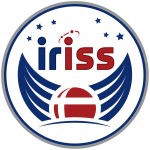
Revitalisation of our Network Group with Zoom, Mural and Excellent Facilitation
We finally got a meeting in the network again – and it was much needed! Throughout the network’s 7-year lifespan, all our
The fourth of ESA’s ‘Class of 2009’ astronauts to fly, Andreas Mogensen from Denmark is well into a ten day mission to the International Space Station. With a background in aerospace engineering, he has spent the last six years training with the Station’s international partners for his inaugural spaceflight, taking part in a wide variety of activities to prepare him for the IRISS Mission.
IRISS is a combination of Iris and ISS, the International Space Station. Iris was the the messenger of the gods in Greek mythology, and the personification of the rainbow. As such, Iris represents the connection between humankind and cosmos.
 The wings of the logo represents the wings of Iris, but also represents a Viking ship. For Andreas, the 6 stars represent his 6 years of training for the mission. Last week, the thousands of hours spent culminated with the launch from Baikonur, Kazakhstan on September 2nd, 2015 at 06:34 Danish time. The Soyuz TMA-18M was coupled to the ISS Space Station at 12:48, and we expect him to land on September 12. 2015 with TMA-16M.
The wings of the logo represents the wings of Iris, but also represents a Viking ship. For Andreas, the 6 stars represent his 6 years of training for the mission. Last week, the thousands of hours spent culminated with the launch from Baikonur, Kazakhstan on September 2nd, 2015 at 06:34 Danish time. The Soyuz TMA-18M was coupled to the ISS Space Station at 12:48, and we expect him to land on September 12. 2015 with TMA-16M.
You will note from the above that Andreas will travel to the ISS Space Station in one Module, and return in another; this is because the remaining crew need a new module for their return to Earth, which will take place around 6 months from now. In Denmark, it is of course not the first time that we (according to a common urban myth) are using highly qualified PhD’s as taxi drivers :-)
The whole project is described in detail on the Danish site rumrejsen.dk.
Andreas Mogensen describes himself as an astronaut, a cavenaut, and an aquanaut. Obviously, he has spend a lot of time in the air, and in various full-scale replicas of the ISS Space Station, the Soyuz rocket etc. But he has also, as part of his training, explored a cave in Sardinia for 1 full week, and been working in the worlds only underwater R&D facility, in the Aquarius underwater habitat outside the coast of Florida.
The Soyuz rockets have been in use for almost half a century, and are the most used space vehicles in the world. Soyuz have contained more than 1,700 manned and un-manned launches – much more than any other rocket. In innovation terms, one could say that Soyuz is a so-called dominant design, and it is characterised by low cost and high reliability.
When that is said, nobody has any doubts that space exploration is associated with risks – serious risks. Regardless of the track record of Soyuz, quite a few astronauts and cosmonauts have paid the ultimate price in order to fulfil their life dream.
| Activity | 1 in | Risk relative to Space Exploration | |
| Climbing Mount Everest | 16 | 1,1 | times more risky than S.E. |
| Space exploration | 17 | 1 | |
| Motor vehicle driving | 140 | 8,2 | times less risky than S.E. |
| Air transport | 55000 | 3235 | times less risky than S.E. |
No doubt that Space Exploration is dangerous, but it is thought-provoking that driving a car is only 8,2 times less risky. And yet, everybody that I know who witnessed the Challenger disaster on the news will ever forget that. It’s right up there with 9-11, Chernobyl, and the Palme assassination.
And that’s a key point, I think: In Space Exploration, there’s no such thing as operating under the radar: The whole world is watching, in success as well as in disaster.
Since the early days of space travel, the huge cost of such programs have been debated. One of the cases that have most often been made is the case for spin-off innovation. In the short video below, you will find a top-10 list of innovations derived from space programs:
On the site 26 NASA Inventions That We Take For Granted Everyday… there is a similar list, including e.g. CAT Scanners, the joystick, and space blankets.
On Top Inventions discovered during WW2 we find this list:
Glancing over the Space List and the WW2 list, it would appear that the WW2 inventions are more radical than the Space inventions – and that many of the uses from Space inventions are consumer inventions, adapted from the original inventions. The WW2 inventions, on the other hand, seem to be B2B inventions for the most part, and inventions that can be recognised pretty much from the original inventions.
These days, the fact that refugees are coming to Europe is stirring heated debate everywhere. A tiny fraction of the many Syrian refugees has made it to Greece, Germany, Denmark, and other European countries. These people are fleeing from life-threatening situations in their homeland. Part of the space exploration program, e.g. the Mars program, is to colonise other planets with earthlings, in case the Earth becomes uninhabitable, due to environmental, nuclear or other disasters.
Perhaps it is time that we put some of our creative juices into the development of innovative solutions for the explorers that are crossing the frontiers here on Earth – instead of pretending that this challenge is not a concern of ours. It would definitely serve our planet better, if my PhD Turkish taxi driver was not driving a taxi – he could be a much happier citizen if he was given the opportunity to put is PhD to relevant use.
We may not be able to afford a 6-year intensive training program for our Turkish PhD taxi driver as the one our Danish PhD taxi driver has been through – but we must do better than just accept that his education is wasted on driving people to and from the airport. And the whole taxi business is being disrupted by Uber anyway, so we might as well embrace that change, right here, right now!

We finally got a meeting in the network again – and it was much needed! Throughout the network’s 7-year lifespan, all our

The collaboration with Finn Kollerup was very rewarding for us. He inspired our participants to think about their everyday challenges in a new

Our task was to facilitate an efficient process and collect the results from a high-profile meeting. A special factor was that the schedule